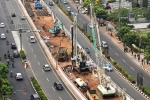JTTS boosts logistics flow at Kuala Tanjung Port
This article has been translated by PwC Indonesia as part of our Indonesia Infrastructure News Service. PwC Indonesia has not checked the accuracy of, and accepts no responsibility for the content.
Investor Daily - JTTS pacu arus logistik di Pelabuhan Kuala Tanjung
17 October 2024
Jakarta, ID – The Trans-Sumatra Toll Road (JTTS), particularly the Indrapura-Kisaran segment, can facilitate the flow of logistics to and from Kuala Tanjung Port in Batu Bara Regency, North Sumatra.
As his administration nears its end, Indonesian President Joko Widodo (Jokowi) inaugurated two segments of the JTTS in the provinces of Jambi and North Sumatra. These segments are the Batung-Tempino segment section 3 (Bayung Lencir-Tempino) in Jambi Province and the Indrapura-Kisaran segment section 2 (Lima Puluh-Kisaran) in North Sumatra Province.
"This afternoon, I am inaugurating the Indrapura-Kisaran segment section 2 (Lima Puluh-Kisaran) in North Sumatra Province and the Batung-Tempino segment section 3 (Bayung
Lencir-Tempino) in Jambi Province," Jokowi stated, as cited from the official YouTube channel of the Presidential Secretariat on Wednesday (16/10/2024).
The President remarked that both segments are part of the government's efforts to accelerate the development of the Trans-Sumatra Toll Road. This initiative is crucial for enhancing regional mobility and economic competitiveness.
“With these toll segments, we expect the Trans-Sumatra Toll Road to accelerate the mobility of passengers, goods, and logistics distribution. This will enable each region to compete more effectively against other countries, as international competition is currently very fierce,” Jokowi revealed.
He noted that toll road development in Indonesia involves various funding sources, including the private sector, state-owned enterprises (SOEs), and the state budget (APBN).
Additionally, the two JTTS segments were constructed and are managed by an SOE, PT Hutama Karya (Persero).
The President added that a mix of funding sources is necessary for construction, especially for projects with a low internal rate of return (IRR), where the APBN becomes crucial to cover financing. "Toll roads have a low IRR, so the APBN must be included," he emphasised.
Jokowi explained that the Bayung Lencir-Tempino segment section 3, spanning 34 kilometres (km) in Jambi Province, costed Rp5.6 trillion and took two years to complete.
Meanwhile, the Indrapura-Kisaran segment, spanning 47.75 km in North Sumatra, was initiated in 2018 with an investment of Rp6.32 trillion.
The Indrapura-Kisaran segment consists of two sections: section 1, Indrapura-Lima Puluh, spanning 15.6 km, and section 2, Lima Puluh-Kisaran, spanning 32.15 km. President Jokowi hopes that these segments will create new economic growth centres in Jambi and North Sumatra, thereby strengthening the competitiveness of both provinces.
“This will improve competitiveness and create new economic growth centres in North Sumatra and Jambi,” he stated.
Shorten travel time
During the occasion, Transportation Minister Budi Karya Sumadi welcomed the development of the Trans-Sumatra Toll Road, particularly the Indrapura-Kisaran segment, which will facilitate the logistics flow to and from Kuala Tanjung Port.
“Port performance must be improved. The toll road will provide a logistics route, shorten travel time, and increase cargo traffic at Kuala Tanjung Port,” the Transportation Minister stated.
Kuala Tanjung Port, located in Batu Bara Regency, North Sumatra, features a dock measuring 500 x 60 metres and a 2.8 km trestle that supports four truck lanes with a width of 18.5 metres. The port's strategic location in the Malacca Strait, one of the main global trade routes, further enhances its significance.
Kuala Tanjung Port is expected to become a transshipment hub, attracting large ships from various countries. Additionally, the port has been integrated with the Sei Mangkei Special Economic Zone (SEZ) via railway, further enhancing logistics distribution.
Hutama Karya President Director Budi Harto stated that both toll segments will reduce travel time between regions by more than 60%. The Indrapura-Kisaran segment, spanning 56 km, has been operating since 15 May 2024. Travel time from Medan to Kisaran now only takes 1.5 hours, down from the previous 5 hours.
“Meanwhile, travel from Indrapura to Kisaran has been reduced from 2 hours on public roads to just 30 minutes. Similarly, the journey from Bayung Lencir to Tempino now takes only 30 minutes, down from the previous 1.5 hours,” Budi explained.
According to him, the Lima Puluh-Kisaran segment is expected to enhance connectivity in North Sumatra, particularly among Kisaran, Medan, and Pematang Siantar, by providing more efficient travel times and improved mobility for the people. In addition to supporting the development of the Sei Mangkei SEZ as an industrial growth centre, the segment also has the potential to boost the tourism sector in the Lake Toba and Pematang Siantar areas by offering better access for both domestic and international tourists.
Meanwhile, the Bayung Lencir-Tempino section, which is part of the Betung (Sekayu Interchange)-Tempino-Jambi segment, is the first toll road in Jambi Province. It enhances connectivity and accessibility between Jambi Province and South Sumatra Province.
To date, Hutama Karya has constructed a total of 1,235 km of the Trans-Sumatra Toll Road (JTTS), which includes both construction support and operational segments. The construction support segment spans 390 km, while the operational segment covers 845 km.
Supporting infrastructure
Meanwhile, an infrastructure observer from Universitas Trisakti, Yayat Supriatna, stated that the integration of every transportation infrastructure must be the responsibility of the state. Roads and access routes to terminals and ports should complement and support each other.
“So, there must be access routes that support each other, whether they are national roads or toll roads. If infrastructure development is carried out in a piecemeal fashion, constructing ports without the accompanying access roads for goods distribution will be challenging,” he told Investor Daily.
He mentioned that the efforts made by the government over the past ten years in constructing the JTTS have not yet yielded full benefits in the short term. According to him, toll road infrastructure development serves as the initial capital to create new economic access and foster the growth of industrial centres.
“I believe the Trans-Sumatra Toll Road will create industrial centres that will invigorate the economy in Sumatra. Regional governments must not be complacent, they have to respond by providing ease of permits for new investors,” he revealed.
He added that many other infrastructure projects still require supporting infrastructure, such as roads and access to industrial centres in various regions. "Infrastructure will not be a waste. They can attract and be sustained by investors as long as the government guarantees business certainty," he noted.
Contact us















